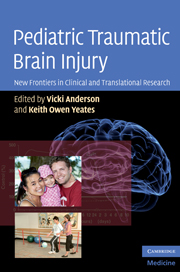Book contents
- Frontmatter
- Contents
- List of contributors
- Acknowledgments
- Introduction: Pediatric traumatic brain injury: New frontiers in clinical and translational research
- 1 Biomechanics of pediatric TBI
- 2 Neurobiology of TBI sustained during development
- 3 Using serum biomarkers to diagnose, assess, treat, and predict outcome after pediatric TBI
- 4 Clinical trials for pediatric TBI
- 5 Advanced neuroimaging techniques in children with traumatic brain injury
- 6 Neurobehavioral outcomes of pediatric mild traumatic brain injury
- 7 Very long-term neuropsychological and behavioral consequences of mild and complicated mild TBI: increased impact of pediatric versus adult TBI
- 8 Neurobehavioral outcomes of pediatric traumatic brain injury
- 9 Neuropsychological rehabilitation in children with traumatic brain injuries
- 10 Psychosocial interventions
- 11 Pediatric TBI: challenges for treatment and rehabilitation
- 12 Integrating multidisciplinary research for translation from the laboratory to the clinic
- Index
- Plate section
- References
7 - Very long-term neuropsychological and behavioral consequences of mild and complicated mild TBI: increased impact of pediatric versus adult TBI
Published online by Cambridge University Press: 14 May 2010
- Frontmatter
- Contents
- List of contributors
- Acknowledgments
- Introduction: Pediatric traumatic brain injury: New frontiers in clinical and translational research
- 1 Biomechanics of pediatric TBI
- 2 Neurobiology of TBI sustained during development
- 3 Using serum biomarkers to diagnose, assess, treat, and predict outcome after pediatric TBI
- 4 Clinical trials for pediatric TBI
- 5 Advanced neuroimaging techniques in children with traumatic brain injury
- 6 Neurobehavioral outcomes of pediatric mild traumatic brain injury
- 7 Very long-term neuropsychological and behavioral consequences of mild and complicated mild TBI: increased impact of pediatric versus adult TBI
- 8 Neurobehavioral outcomes of pediatric traumatic brain injury
- 9 Neuropsychological rehabilitation in children with traumatic brain injuries
- 10 Psychosocial interventions
- 11 Pediatric TBI: challenges for treatment and rehabilitation
- 12 Integrating multidisciplinary research for translation from the laboratory to the clinic
- Index
- Plate section
- References
Summary
This chapter is based on three recently published papers (Hessen et al.,2006b; 2007; 2008) that describe different aspects of a 23-year follow-up of primarily mild traumatic brain injury (mTBI) of children and adults in Norway. There are two main purposes of this chapter: first to discuss possible long-term neuropsychological and behavioral consequences of pediatric and adult mild and complicated mTBI; and second to suggest areas of research that might increase our knowledge about neurobehavioral consequences and rehabilitation after pediatric complicated mTBI.
Introduction
Different studies suggest that the annual prevalence of mTBI ranges from 100 to 550 per 100,000 (Andersson et al., 2003; Duus et al., 1991; Evans, 1992; Thornhill et al., 2000). Approximately 80% of all TBI are classified as mild (Kraus & Nourjah, 1988). Regarding pediatric TBI estimates of incidence vary from 185 per 100,000 (Kraus & Rock, 1989) per year to over 300 per 100,000 (British Society of Rehabilitation Medicine, 1988; House of Commons Select Committee on Health, 2001). Most of pediatric cases (81%–86%) are mTBI, about 8% are moderate, 6% are severe, and 5% are fatal (Kraus et al., 1986; 1990). Even after mTBI, it is common to suffer acute cognitive problems, but most persons recover fully within three months (Dikmen et al., 1986; Levin et al., 1987; Rutherford et al., 1978). However, there is a group of patients who continue to experience cognitive, behavioral, and neurological symptoms long after sustaining their injury (Dikmen et al., 1989; Hartlage et al., 2001).
- Type
- Chapter
- Information
- Pediatric Traumatic Brain InjuryNew Frontiers in Clinical and Translational Research, pp. 118 - 144Publisher: Cambridge University PressPrint publication year: 2010
References
- 2
- Cited by



